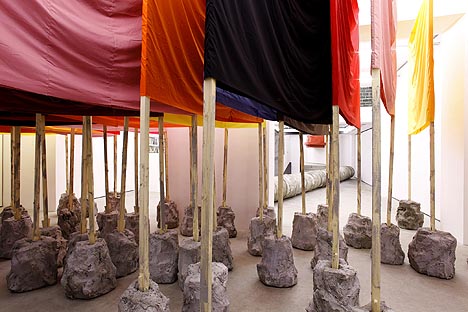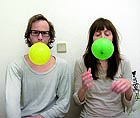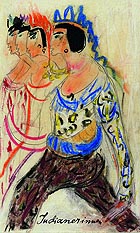
translated and summarized by: Liz Wollner-Grandville,
English summaries September 14 - 30
BAWAG Contemporary
Phyllida Barlow Street
09.09.10 - 27.10.10
Helplessly impressive architecture
It’s more than 40 years since Phyllida Barlow presented her temporary installation “Tent” in which she covered street rubbish with a roof of painted canvas. In spite of this radical sculptural gesture, Barlow was – until a few years ago - hardly known outside Great Britain where she taught at the Slade School of Arts. Today, “Tent” is extant: Barlow doesn’t trouble herself with what has happened to her works; frequently recycles parts of her objects – a similarly radical attitude. But that has certainly changed since she has been under contract with Hauser & Wirth.
Barlow has had two rigs full of art transported to the BAWAG Contemporary. Upon entering the exhibition from the Franz-Josefs-Kai, one first has to fight one’s way through a forest of flags cemented into concrete bases. And if you enter the BAWAG Contemporary from the other side, you find yourself standing before a heap of blackened plywood, pieces of plastic, plaster, pipes and pallets - in other words, objects found in a city which one normally never notices. One is also hardly aware of the types of urban fixtures on which Barlow is also working: Robert Musil already made the observation that there’s nothing quite so invisible as a monument. In Barlow’s interpretation, the monument is both toppled - as in the over-dimensional pillar, which lies in pieces on the floor - or so de-contextualized and displaced that it can no longer be considered as an impressive architectural piece – the appearance of an apparently helpless piece of a tower hanging on the wall and painted red.
The rough texture makes Barlow’s objects appear raw, unpretentious and intractable. Nevertheless, her physical impact is asserted in the room, sometimes even besetting you. Barlow stages something like a street riot. It’s hardly surprising that her earlier works were considered vastly younger; she was already many years before her time in the 1960’s. In short: a true discovery.
By Nina Schedlmayer
BAWAG Contemporary
1010 Vienna, Franz Josefs Kai 3
www.bwagcontemporary.at
Opening hours: Daily from 2 p.m. – 8 p.m.
Startgalerie im Museum auf Abruf
Micha Payer and Martin Gabriel - Eyes on my Ears on my Ears
10.09.10 - 07.10.10
Subtle Dada Pop
Some of the cubes made of everyday trash, which are standing around in the room, remind of César’s Controlled Compressions; in this exhibition, they stand in contrast to the subtle and at the same time, trashy drawings on the walls. These works attract your attention above all because of their collage-like compositions and their decorative character. The material cubes appear to be lacking in any composition – like their models. The connecting link between these very rough-seeming objects and the subtle drawings on the wall is a sculpture made of plastic toys, which have been glued together.
The exhibited works, harmonious and seemingly from one hand, reminds one strongly of the art of Neo-Dadaismus and the pop art of the 1960’s. Jim Dine, Robert Rauschenberg and Tom Wesselman spring to mind during the viewing. Even though the precision of the works is clearly in opposition to the then attitude of Neo-Dada, parallels can be found in the colorings and even more in the motifs: cars, modern people, brand logos – things that, would not be found in a picture by Rauschenberg, but that convey a similar mood because they seem to generate something like an inventory of our present times.
By contrast, the large format Lambda-print with the title “Genetics”, its clarity and distinctiveness reminding of the aesthetics of computer art that the duo Payer-Gabriel not only care about a certain form but about the best possible implementation of their ideas - even if these are not always as clear and unmistakable as in the case mentioned.
By Wolfgang Pichler
Startgalerie im Museum auf Abruf
1010 Vienna, Felderstraße 6-8, next to the Town Hall
www.musa.at/startgalerie
Opening hours: Tue, Wed, Fri: 11 a.m. – 6 pm.; Thu 11 a.m- - 8 p.m.; Sat 11 a.m. – 4 p.m.
Jewish Museum Frankfurt
Else Lasker-Schüler – The Pictures
08.09.10 - 09.01.11
The Expressionist and the Prince
Enter Prince Yusuf of Thebes. He peeps out from between the folds of black curtains. In the exhibition, the visitor enters a sort of stage room in which the characters of Else Lasker-Schüler (1869 - 1945) are exhibited. The presentation has been chosen appropriately, but the woman of letters and the artist played with her own production and different identities, both in her poetical and in her artistic work. Thus she created the world of Prince Yusuf of Thebes who turned into a kind of Alter Ego for her.
Else Lasker-Schüler was a shimmering figure in the Berlin art scene from before the close of the 19th century right up to the time of eviction by the National Socialists in 1933. Her pictures were classified as degenerated. Many were lost in the mayhem of war, which certainly also contributed to the fact that her artistic works fell into oblivion and to this day still stand within the shadow of lyricism. Now, the pictures - comprising 150 drawings, collages, drawings in letters and hand-colored lithographs which, for the first time, show a comprehensive overview of the artistic creation and fantastically colorful world of the expressionist artist - are brought together in “Else Lasker-Schüler. The paintings“. In parallel, a first catalogue raisonné has published by Ricarda Dick, who is also the exhibition’s curator.
The exhibition gives an impressive picture of the artist’s integration into her times. One perceives how her work assimilated and was influenced - not only by actual trends and currents such as, for example, primitivism and orientalism - but also by the creations of her artist colleagues, among them Franz Marc with whom she had a close friendship. The portrayal of Prince Yusuf, which constitutes the main theme complex of her graphic works, was developed in broad outlines subsequent to the extensive Egyptian Exhibition in Berlin in 1913. He combines references to Jewish, Islamic, Christian (= Josef) and ancient Egyptian worlds and exhibits differing cultural spheres such as Lasker-Schüler herself.
By Lotus Brinkmann
Jüdisches Museum
6031 Frankfurt, Untermainkai 14/15
www.juedischesmuseum.de
Opening hours: Tue – Sun 10 a.m. – 5 p.m., Wed 10 a.m. – 8 p.m.
Kunsthalle Exnergasse
Bless my homeland forever - I, too, will try to forget...
16.09.10 - 16.10.10
The elegiacal sound of remembrance
For 22 days the artist, Susan Silas, was on the road on which in April 1945, 580 female Jewish prisoners from a sub-camp of the concentration camp, Flossenbürg were being herded through Germany and Czechoslovakia, and portrayed the happenings by means of coolly poetical photographs: by order of the Allies, 95 women who had died in Volary during the death march, were buried in the front part of the municipal cemetery. After the Allies departure, the inhabitants planted a hedge of trees, which now divides the cemetery into two parts.
Silas’ work, within the framework of the exhibition “Bless my homeland forever” which can be seen in the Kunsthalle Exnergasse, shows one of the ways of handling the area of tension of collective remembrance and repression as thematised by Karoline Mayer, curator of the exhibition. Starting point of the exhibition is the American film, “The Sound of Music” (1965). While tourists from all over the world make pilgrimages to the original Salzburg film locations, the film is largely unknown here. The conclusive hypothesis of the curators, based on the fact that the image of Austria shown in the film is that of a “naïve-creative people (…) who, while not actively supporting the Annexation of Austria, at least confront it in an indifferent manner”, doesn’t concur with the domestic post-war understanding of Austria as Germany’s first victim.
The meritorious exhibition with contributions from 12 countries, questions the relationship between history and identity, as well as the ramifications of collective oblivion, and commemorates the past: such things as the “Verkehrsflächen 1” by Werner Kaligofsky, which documents the streets in Innsbruck named after the opponents of National Socialism but which also documents the often violent opposition to the streets’ renaming.
Karoline Mayer examines the contradictory domestic handling of the past in the “Catalogue of Austrian War Memorials”. Besides the customary homages to the “Heroes of both World Wars”, there is also in Kirchberg-am-Wechsel an inscription to the memory of a deported Jewish merchant’s family.
Especially touching: Ioana Marinescu‘s cinematic installation about the 1948 destruction of an entire city quarter in Bucharest, which was ordered by Ceausescu. In elegiacal-melancholic pictures, the artist traces the deposed inhabitants and shows the inhospitable dereliction which developed during the course of the erection of the megalomaniacal “People’s Palace”
The diligently formed exhibition demands a lot from the visitor – and this is indeed excusable because of the high quality of the contributions. And in spite of the minimal budget, an informative brochure as well as a catalogue was produced once again proves how efficiently the team of the Kunsthalle Exnergasse and their project partners are able to deal with minimal financial resources.
By Susanne Jäger
Kunsthalle Exnergasse
1090 Vienna, Währinger Straße 59, 2. Unit, First Floor
kunsthalle.wuk.at
Opening hours: Tue – Fri: 1 p.m. – 6 p.m., Sat 11 a.m. – 2 p.m.
Mehr Texte von translated and summarized by: Liz Wollner-Grandville


 Teilen
Teilen





